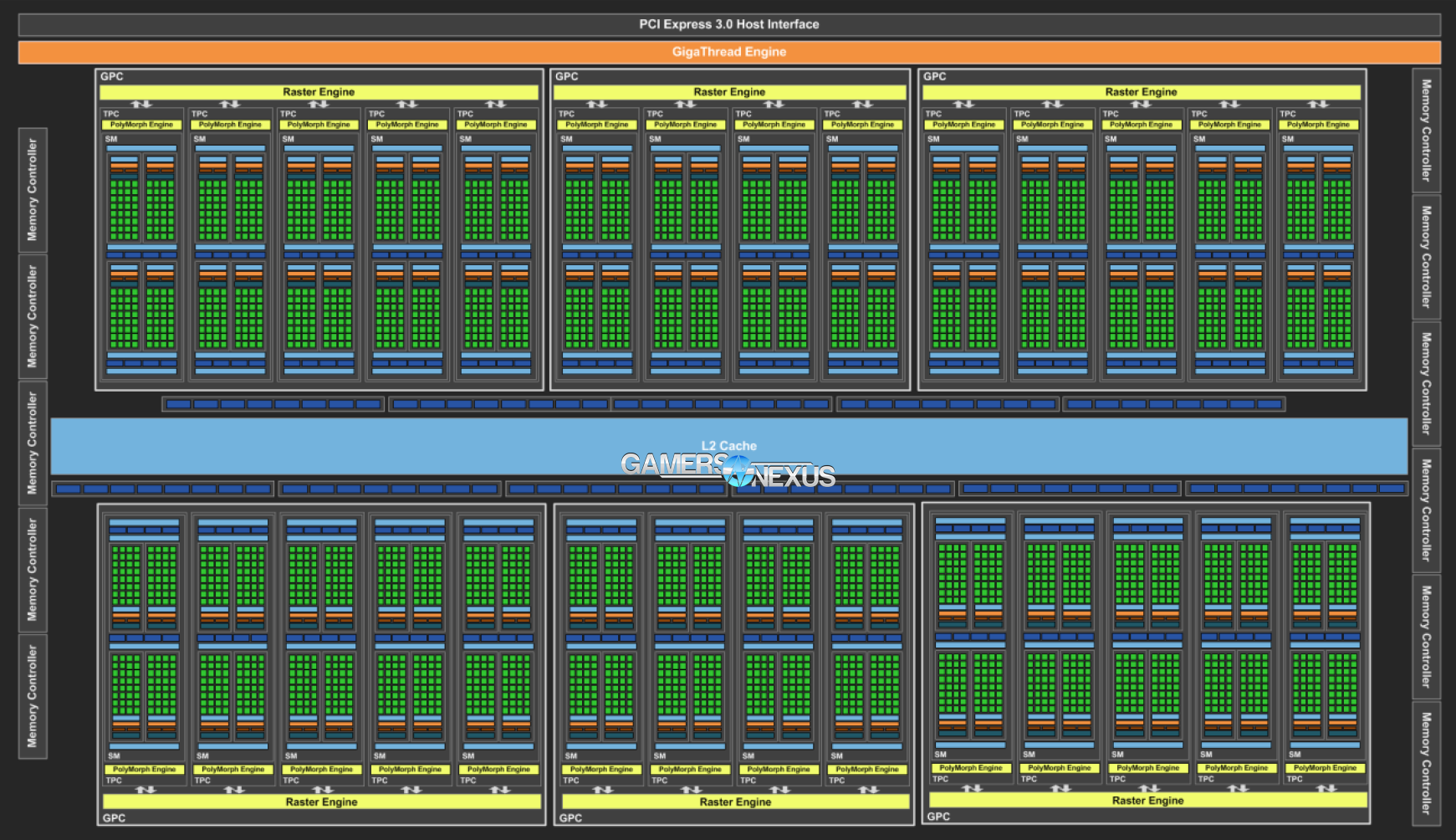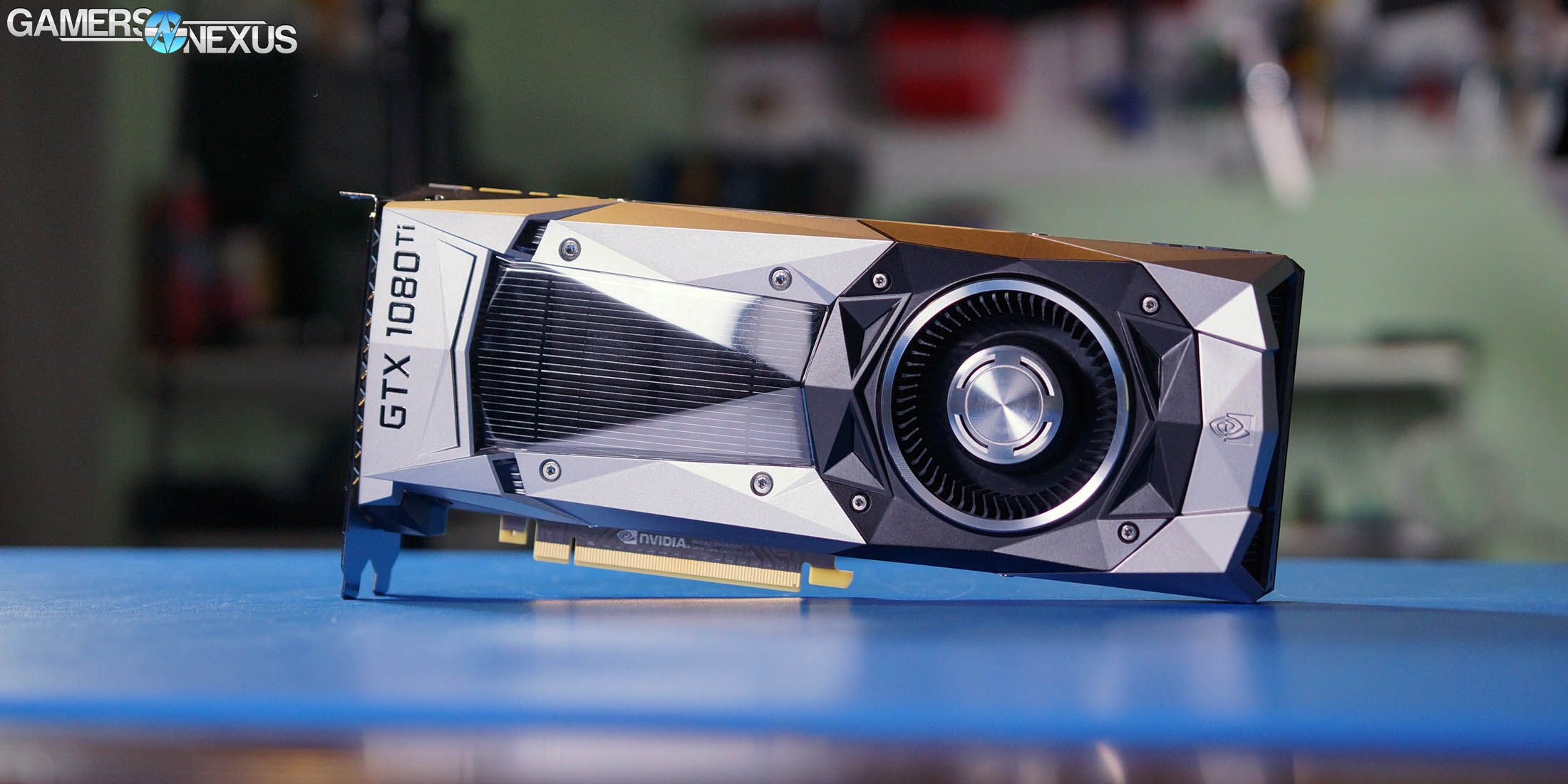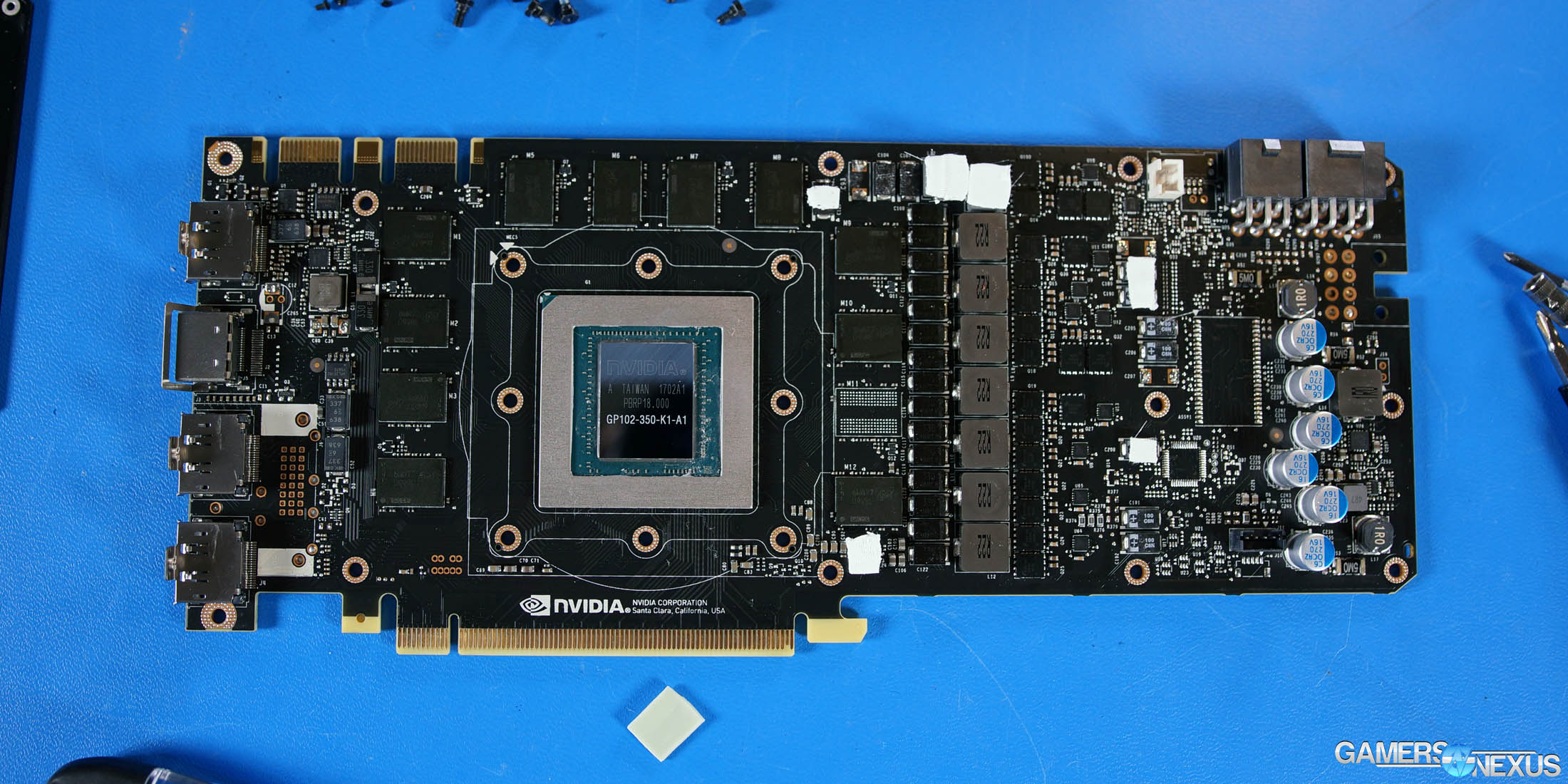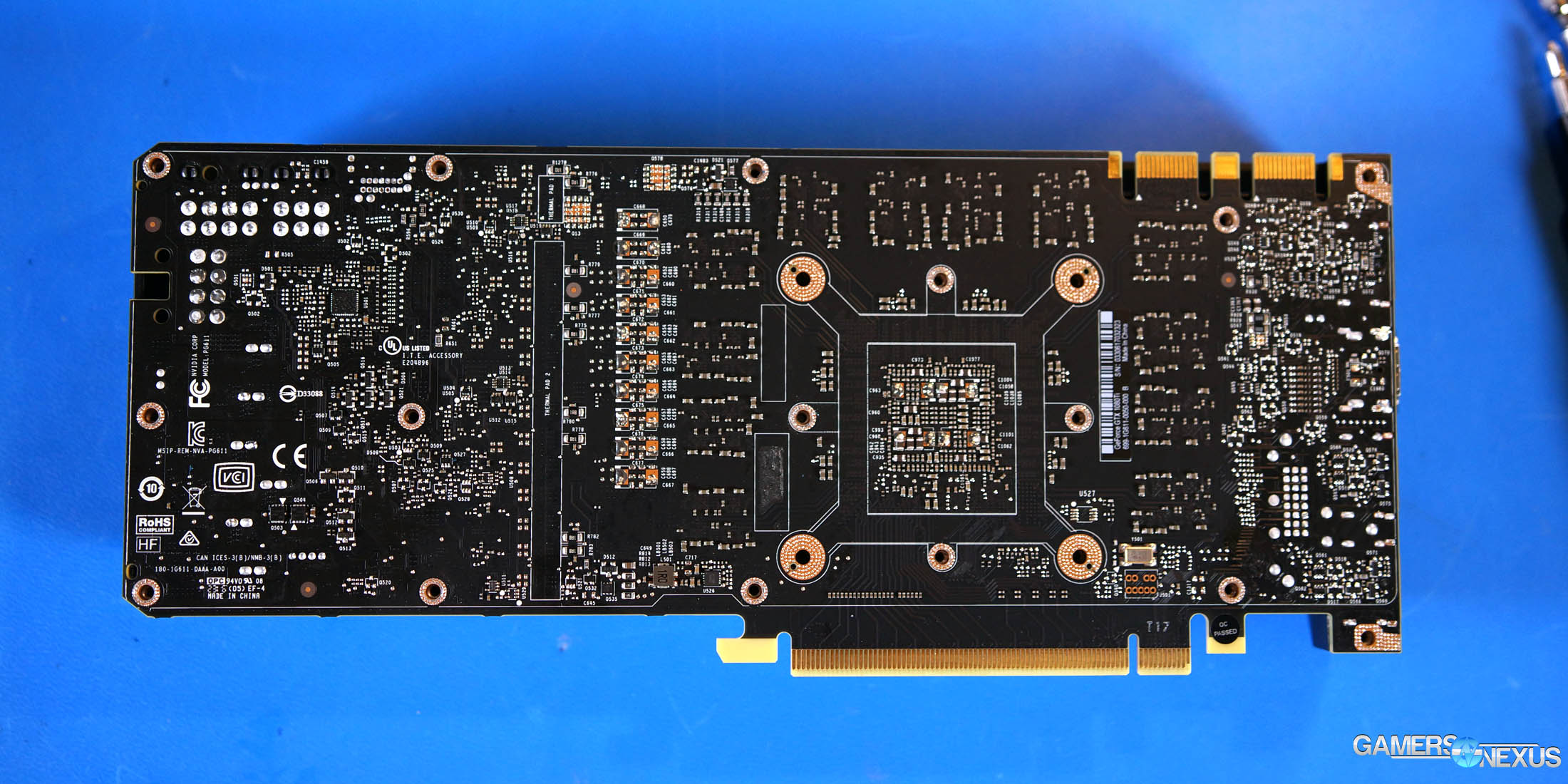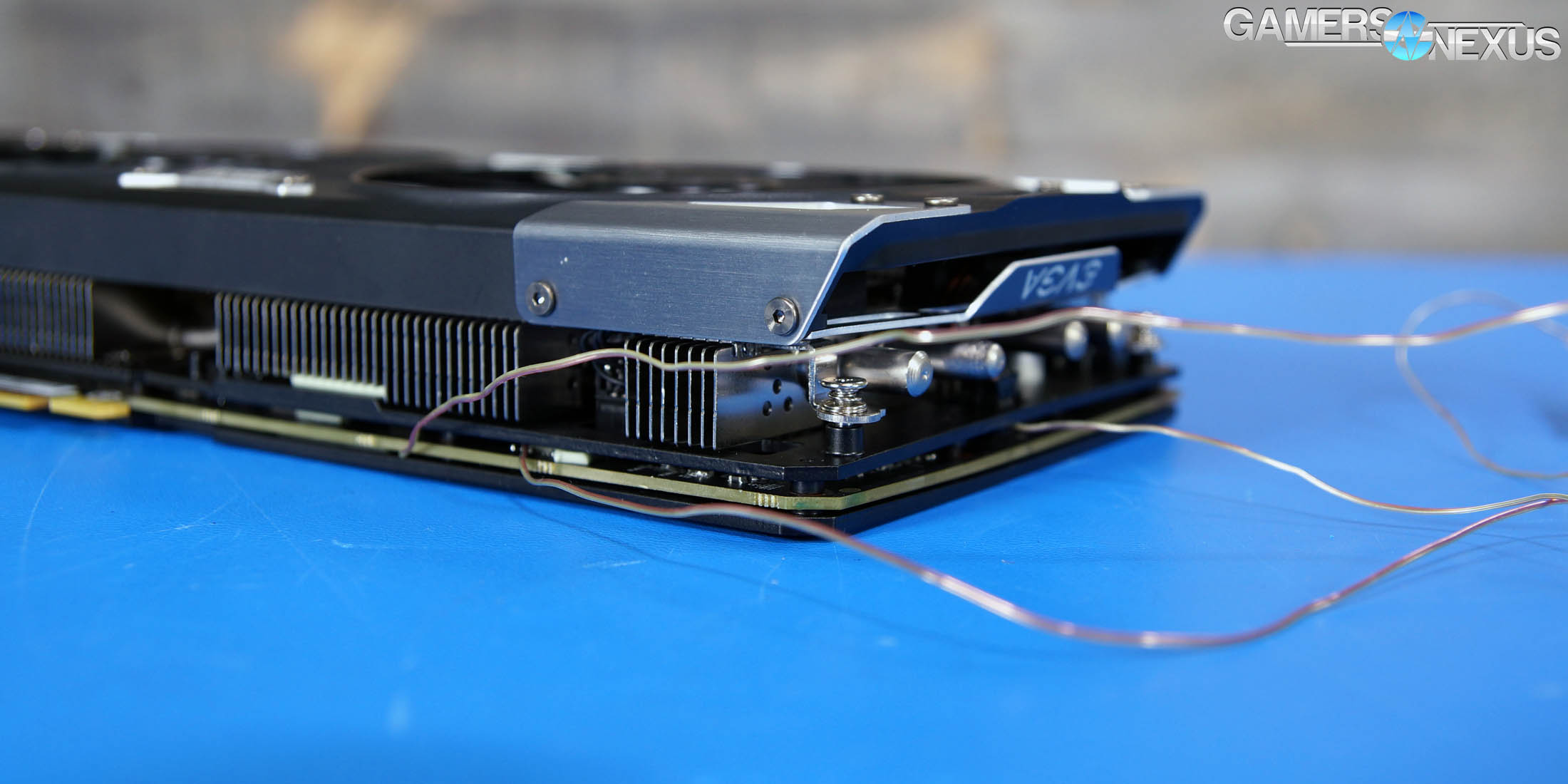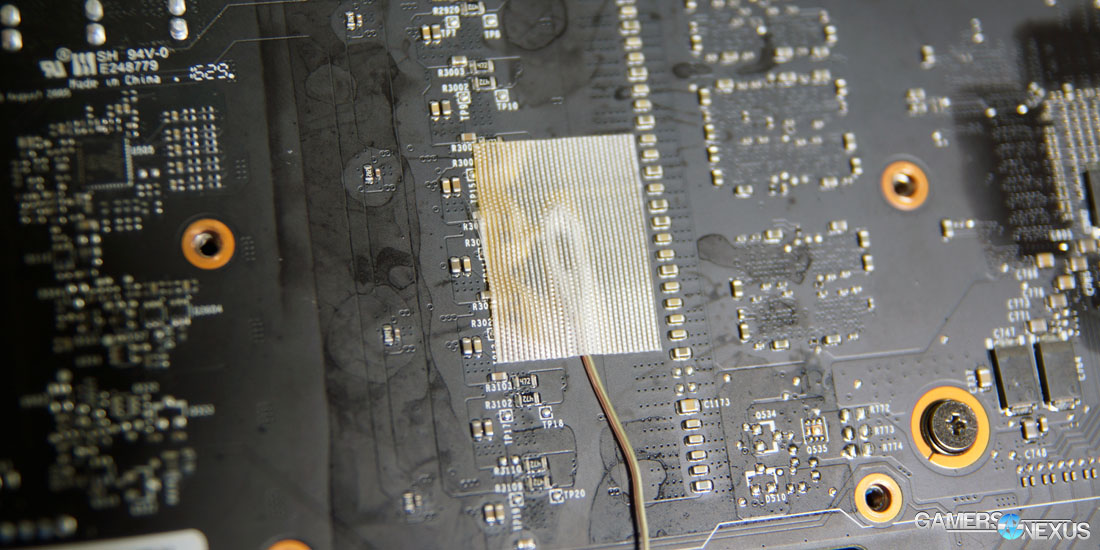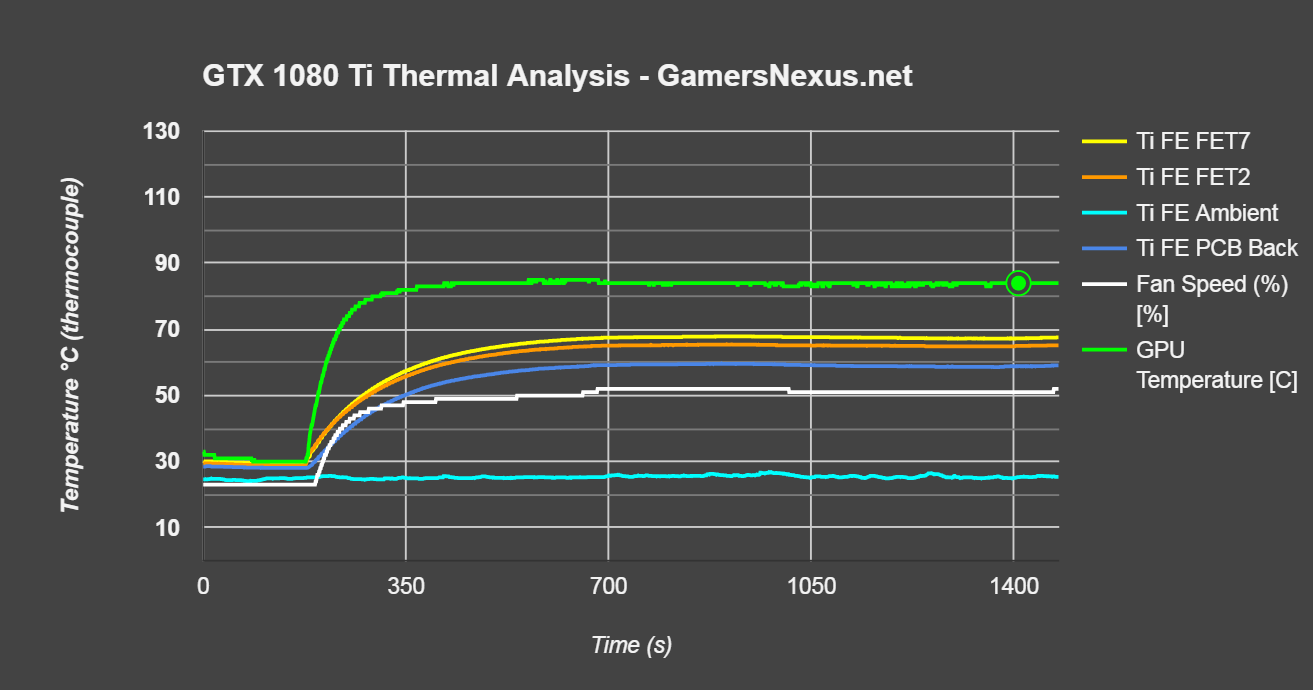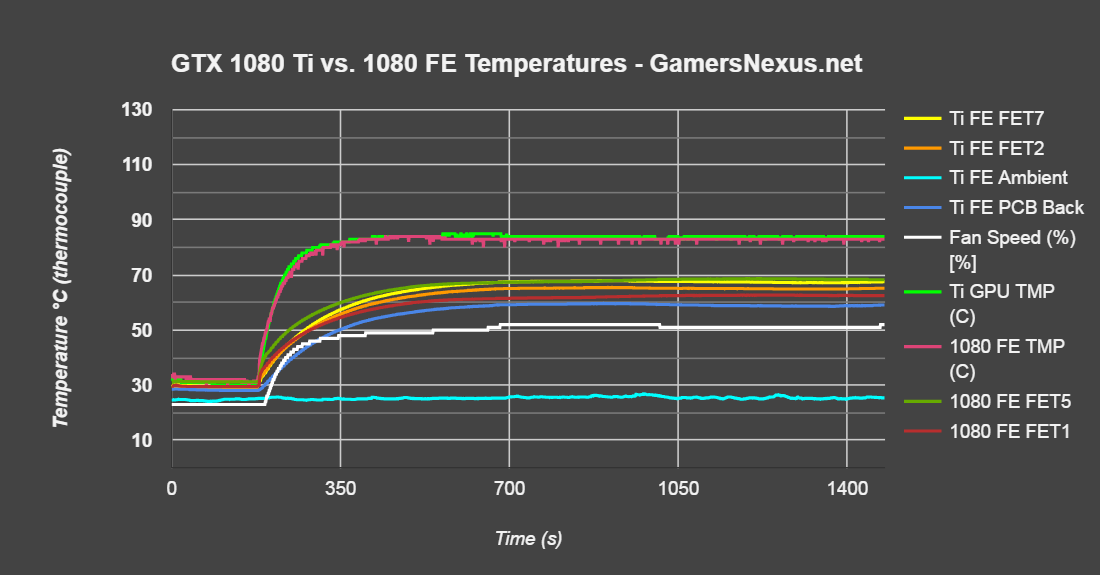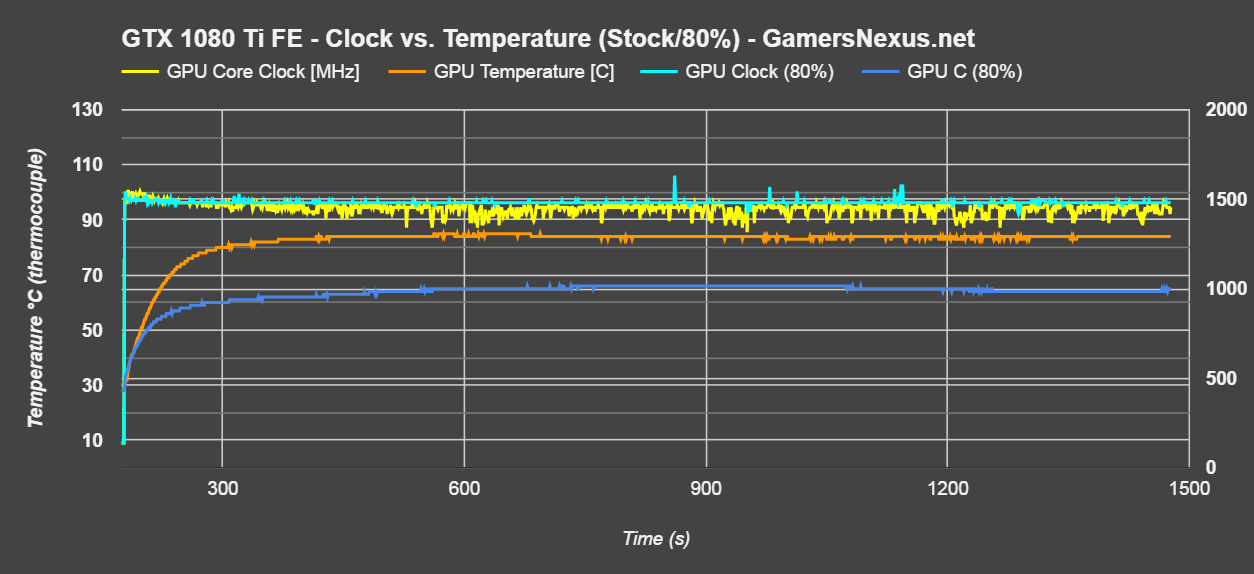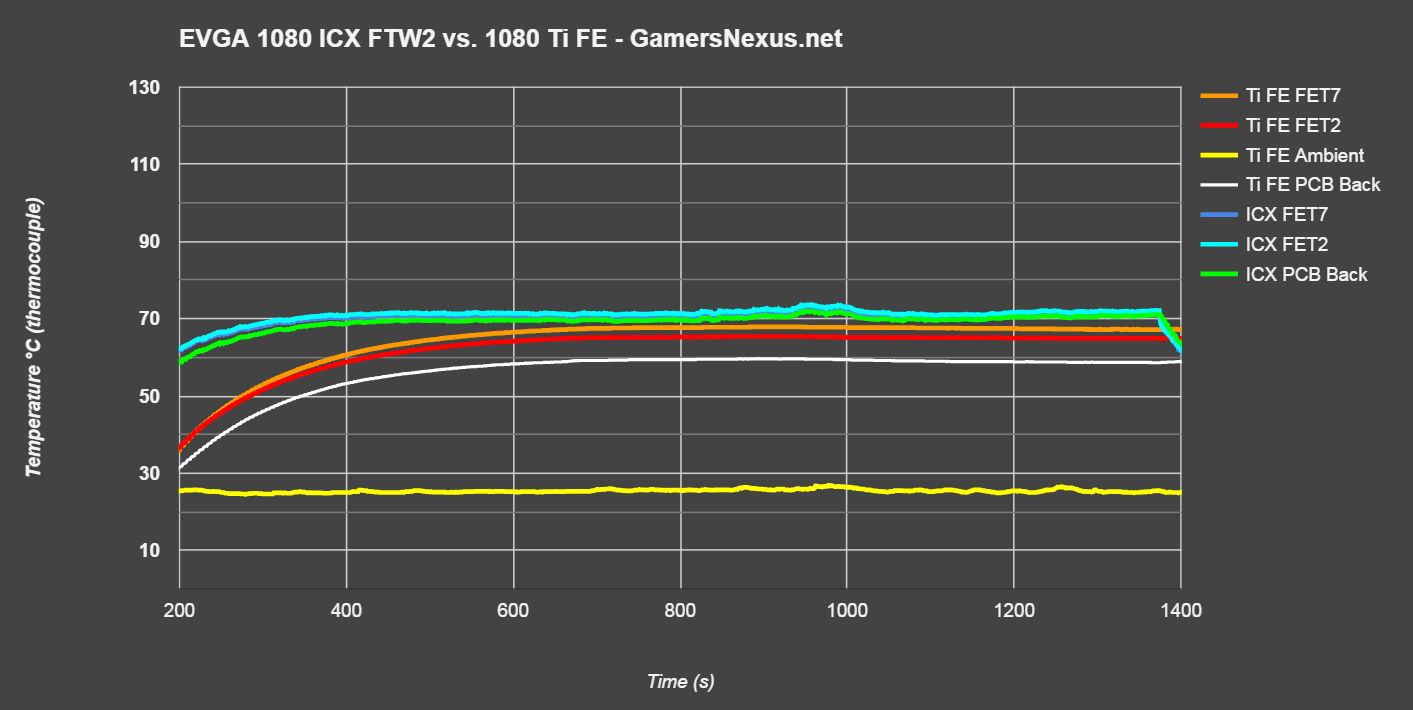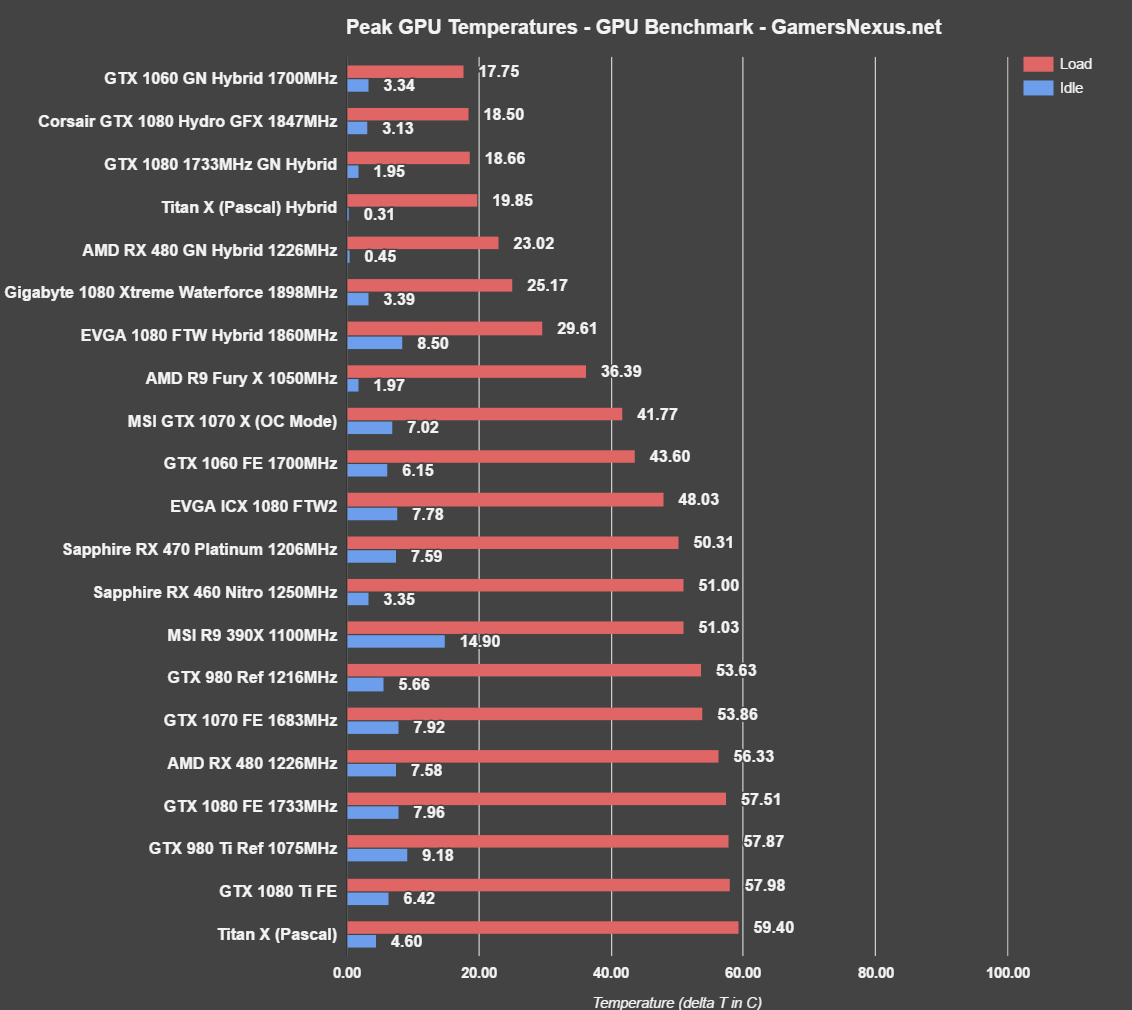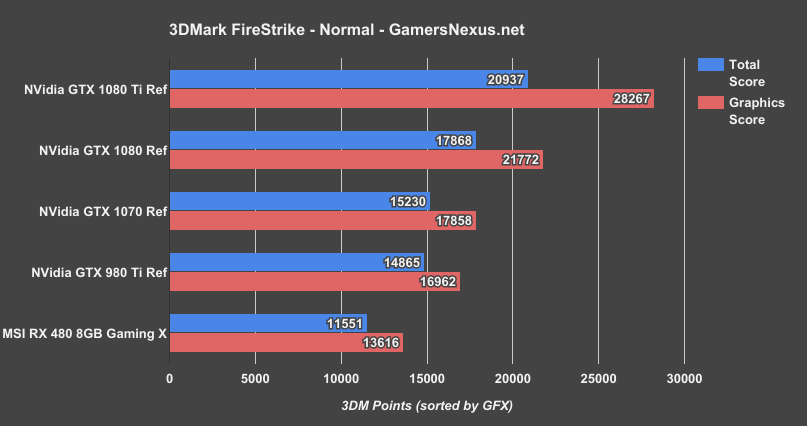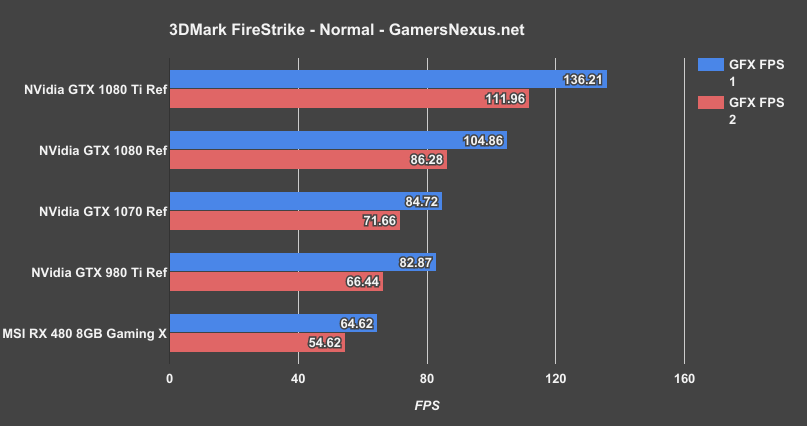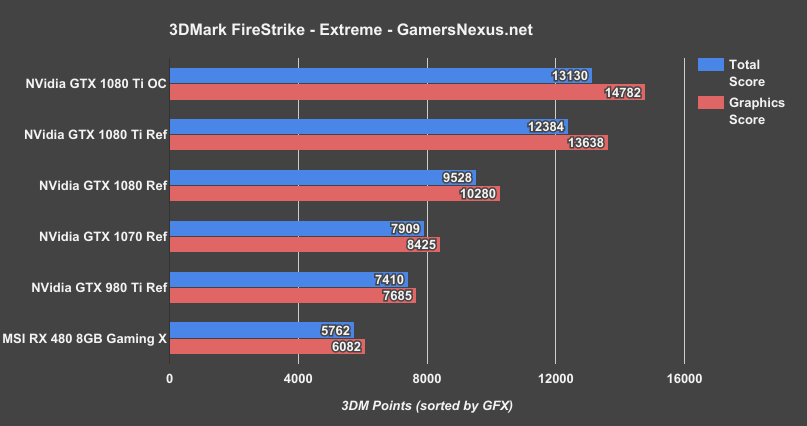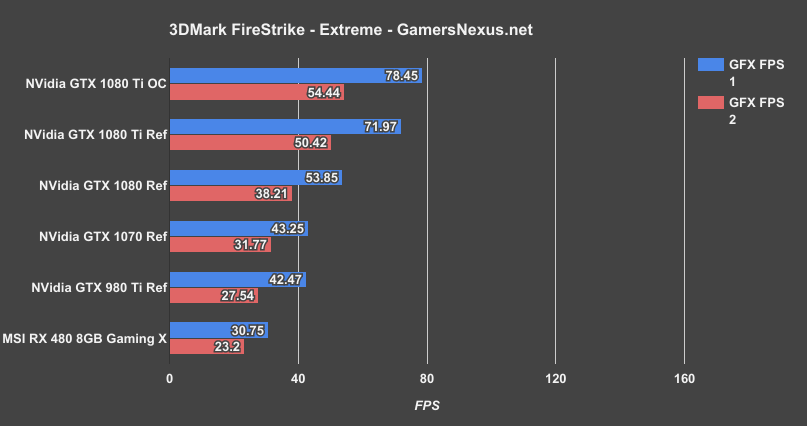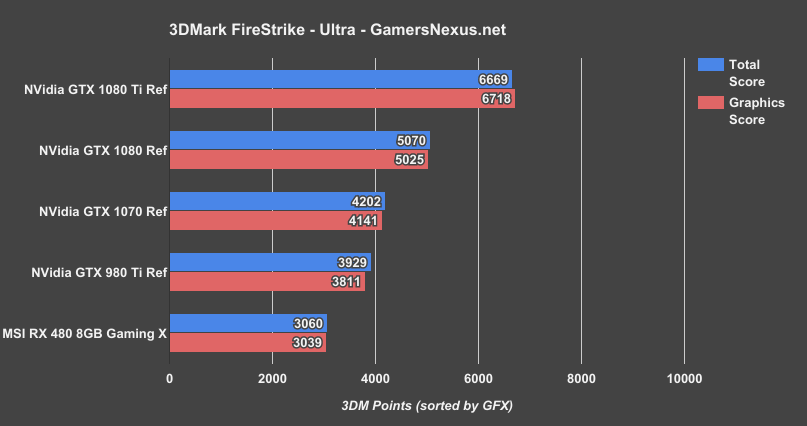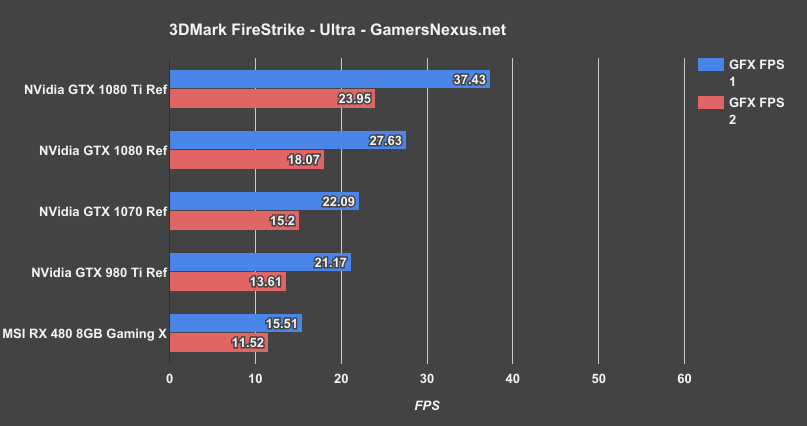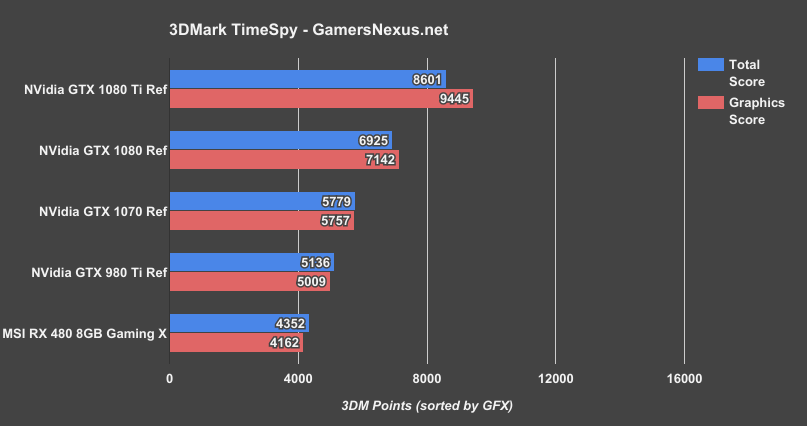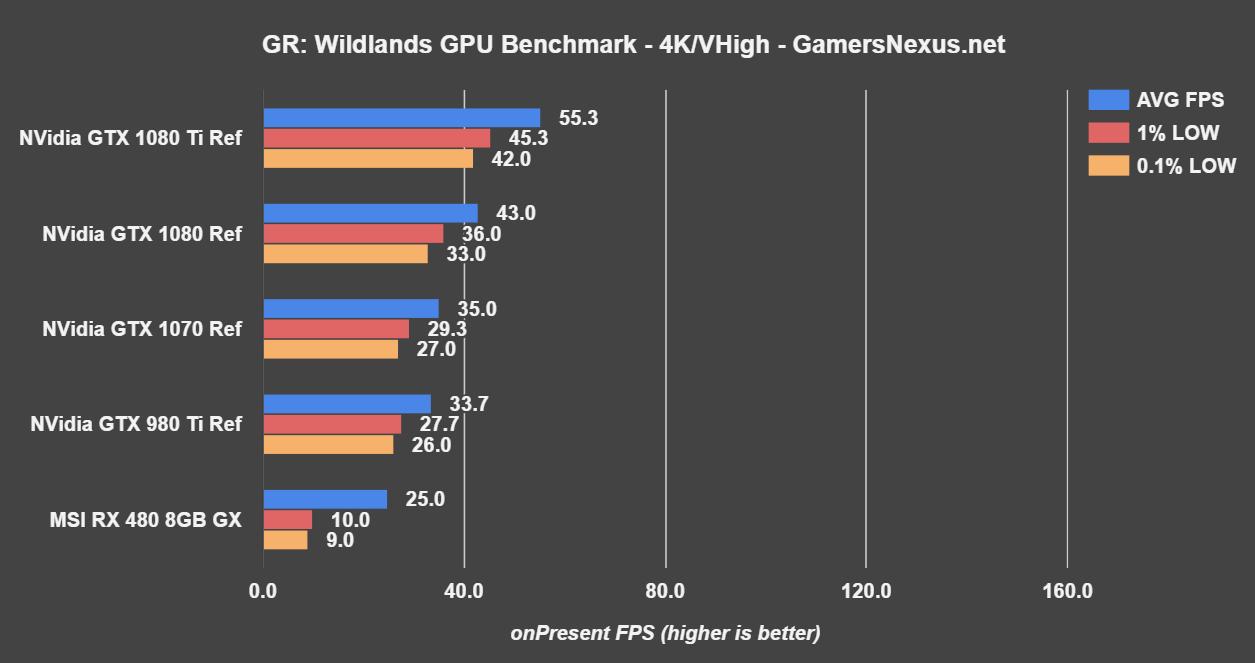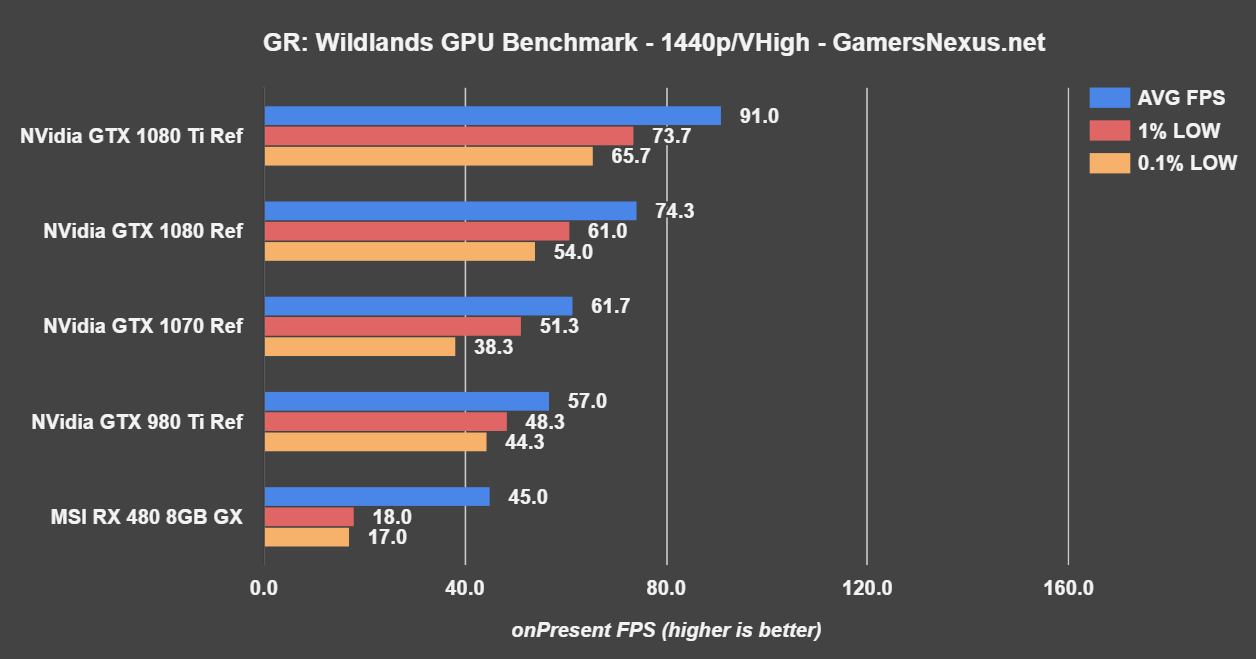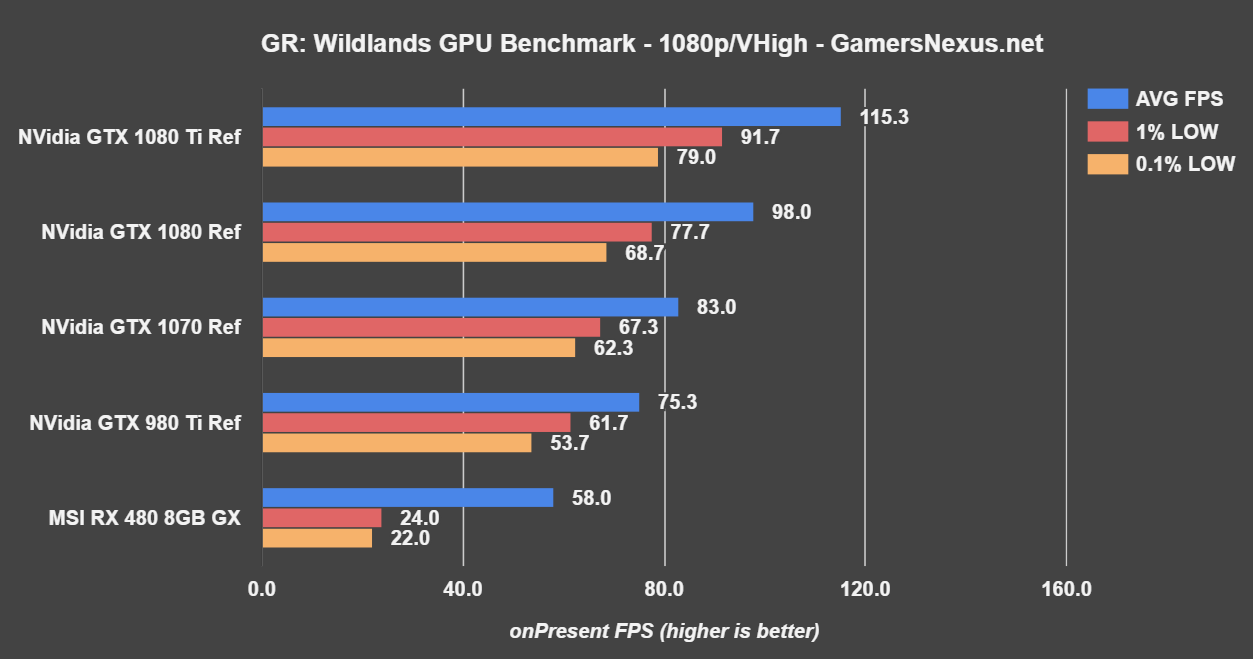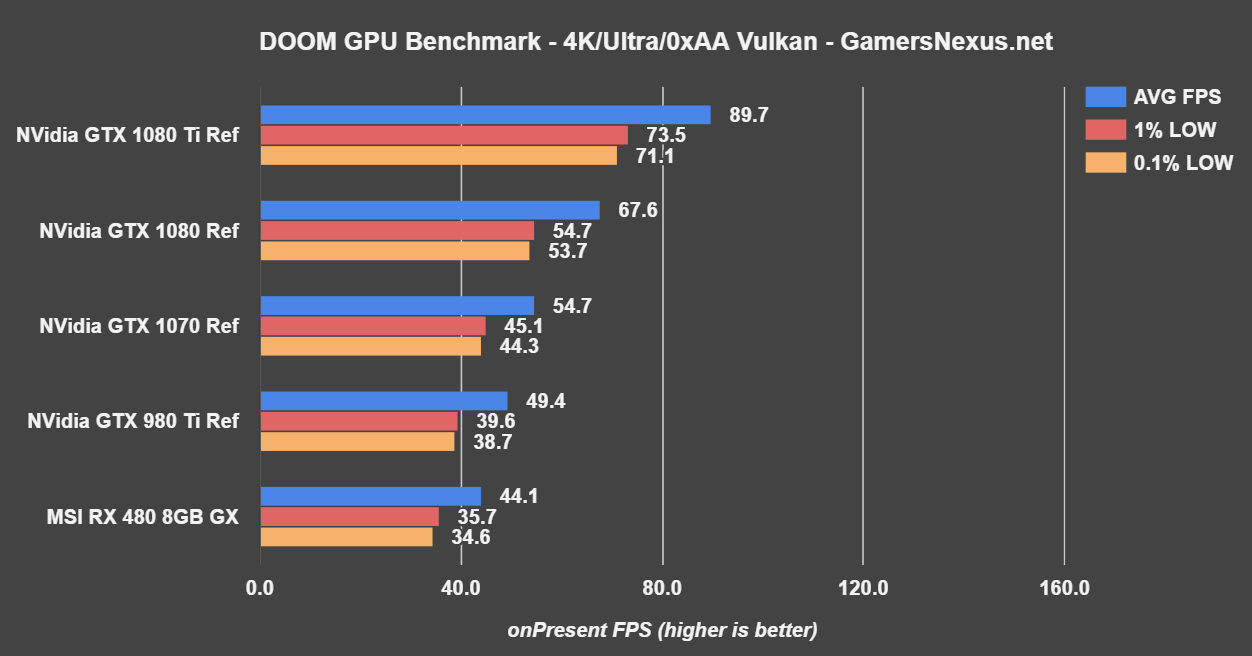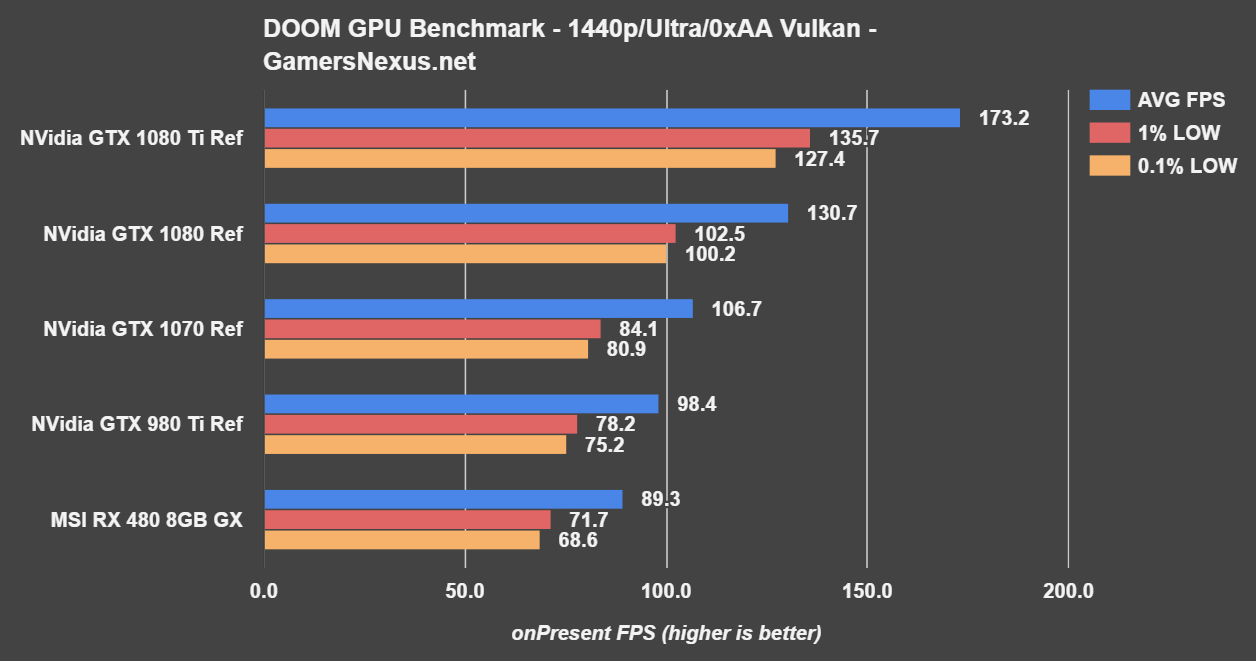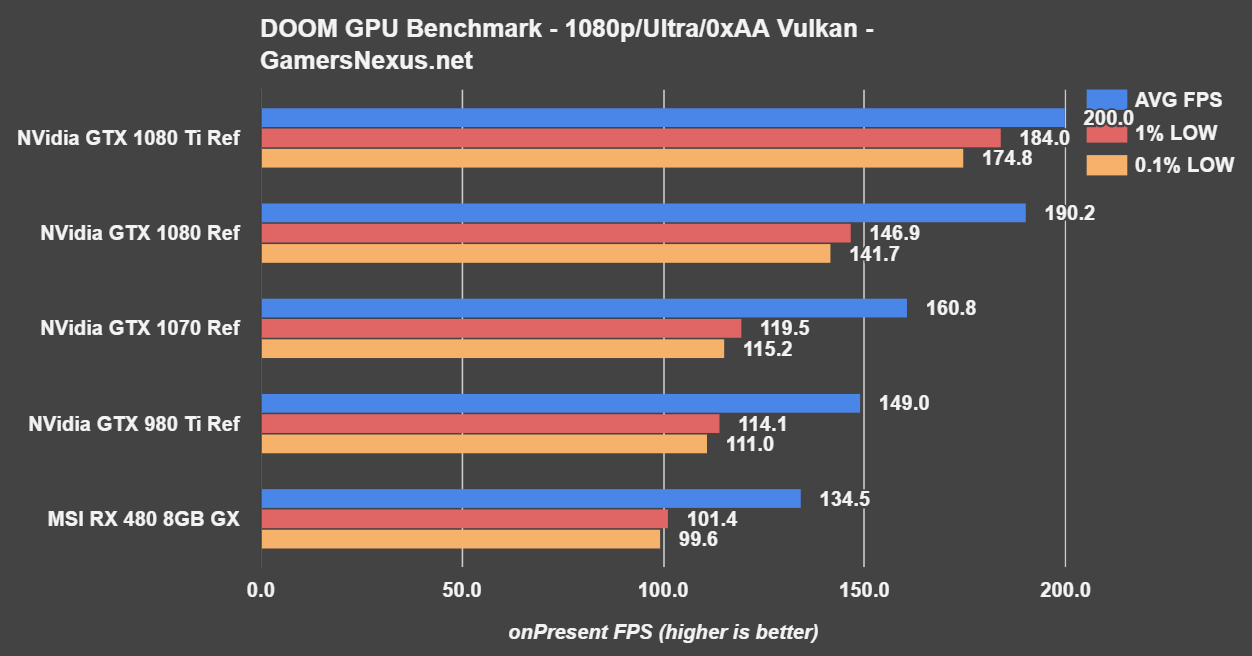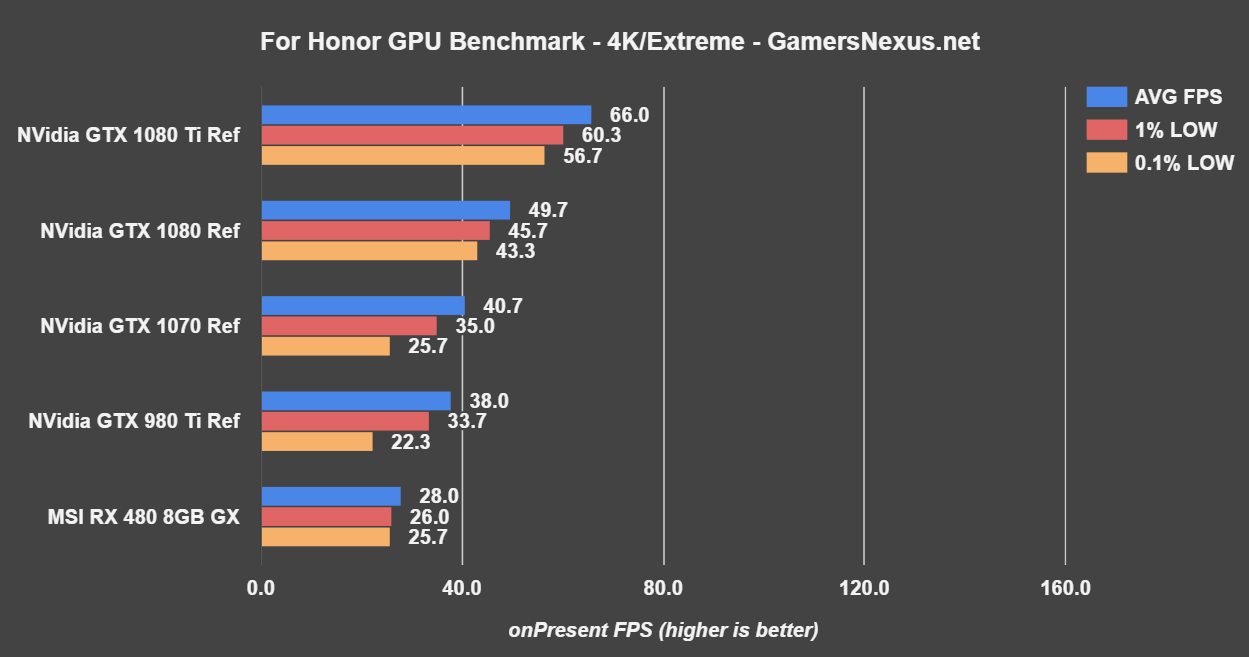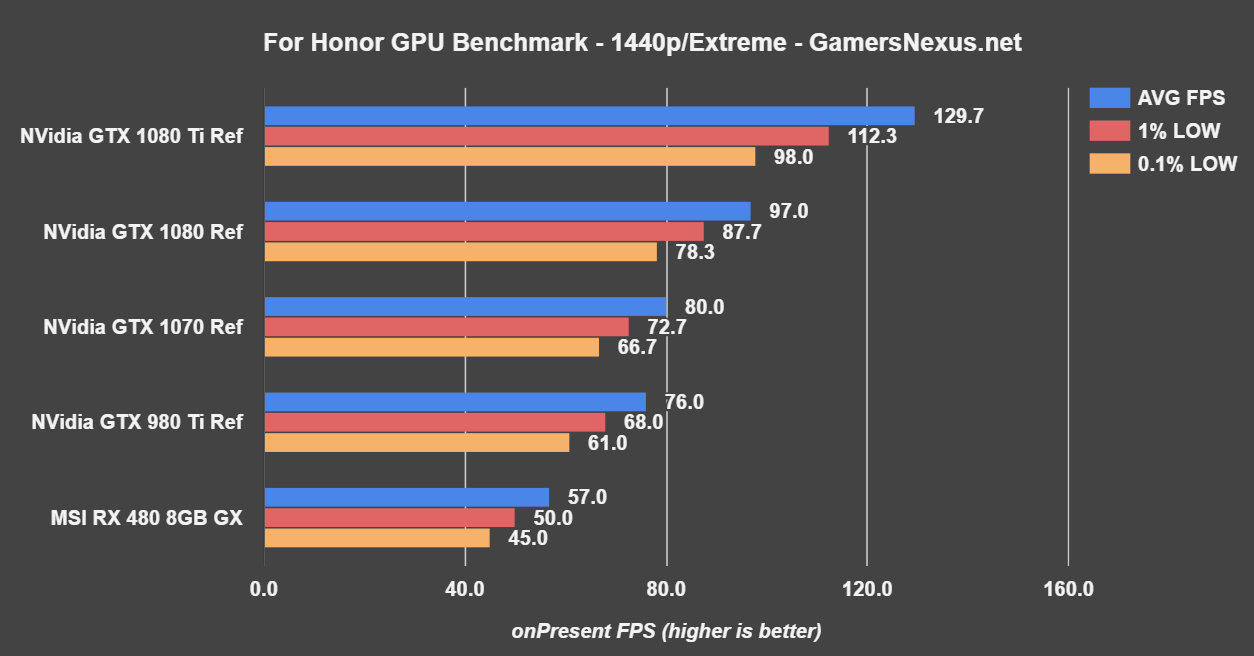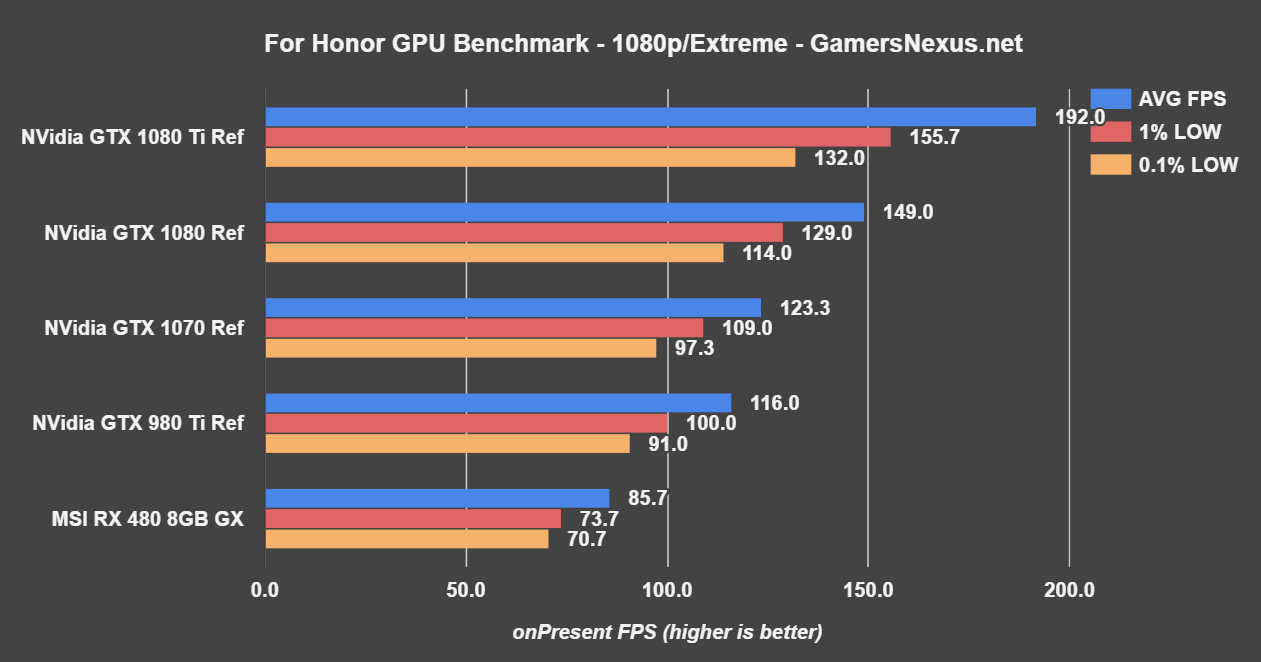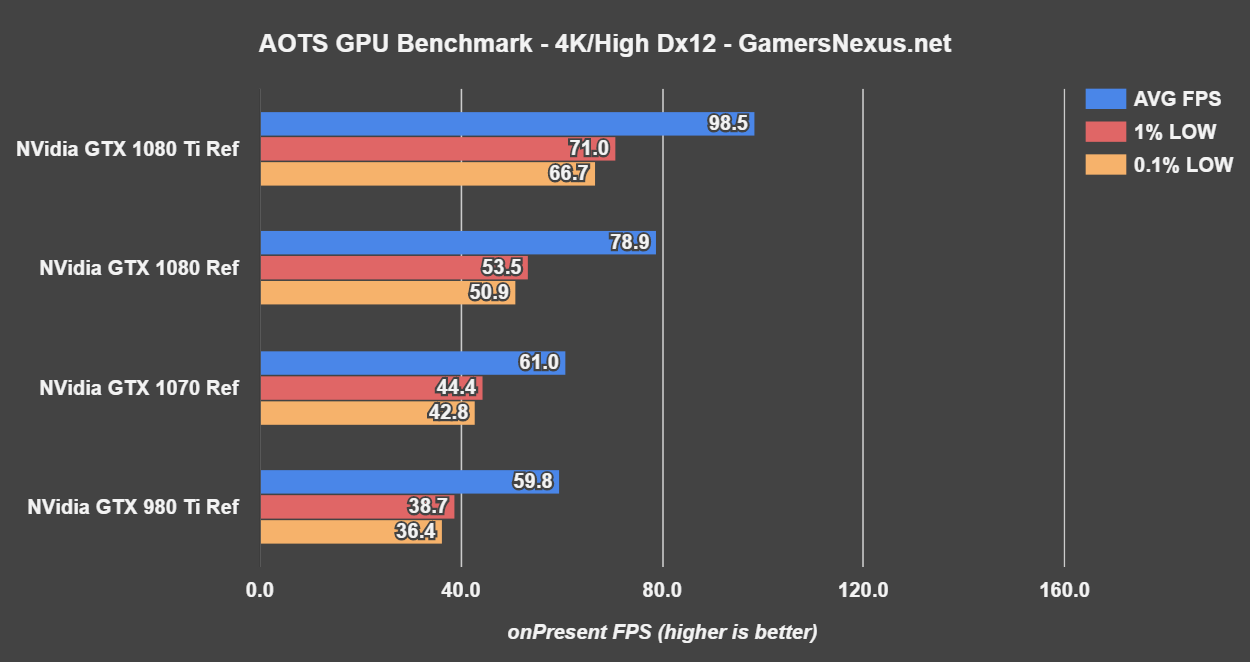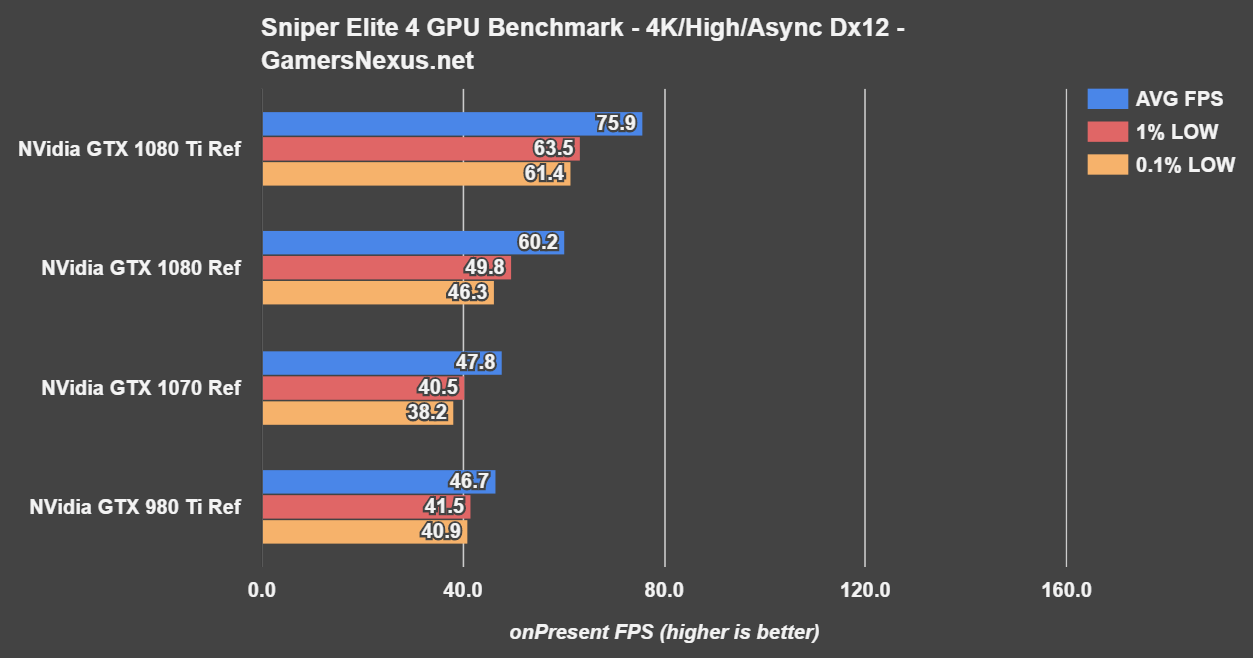The GTX 1080 Ti posed a fun opportunity to roll-out our new GPU test bench, something we’ve been working on since end of last year. The updated bench puts a new emphasis on thermal testing, borrowing methodology from our EVGA ICX review, and now analyzes cooler efficacy as it pertains to non-GPU components (read: MOSFETs, backplate, VRAM).
In addition to this, of course, we’ll be conducting a new suite of game FPS benchmarks, running synthetics, and preparing for overclocking and noise. The last two items won’t make it into today’s content given PAX being hours away, but they’re coming. We will be starting our Hybrid series today, for fans of that. Check here shortly for that.
If it’s not obvious, we’re reviewing nVidia’s GTX 1080 Ti Founders Edition card today, follow-up to the GTX 1080 and gen-old 980 Ti. Included on the benches are the 1080, 1080 Ti, 1070, 980 Ti, and in some, an RX 480 to represent the $250 market. We’re still adding cards to this brand new bench, but that’s where we’re starting. Please exercise patience as we continue to iterate on this platform and build a new dataset. Last year’s was built up over an entire launch cycle.
NVIDIA GTX 1080 Ti Specs vs. 1080, 980 Ti
| NVIDIA Pascal Specs Comparison | ||||
| Tesla P100 | GTX 1080 Ti | GTX 1080 | GTX 1070 | |
| GPU | GP100 Cut-Down Pascal | GP102 Pascal | GP104-400 Pascal | GP104-200 Pascal |
| Transistor Count | 15.3B | 12B | 7.2B | 7.2B |
| Fab Process | 16nm FinFET | 16nm FinFET | 16nm FinFET | 16nm FinFET |
| CUDA Cores | 3584 | 3584 | 2560 | 1920 |
| GPCs | 6 | 6 | 4 | 3 |
| SMs | 56 | 28 | 20 | 15 |
| TPCs | 28 TPCs | 20 TPCs | 15 | |
| TMUs | 224 | 224 | 160 | 120 |
| ROPs | 96 (?) | 88 | 64 | 64 |
| Core Clock | 1328MHz | - | 1607MHz | 1506MHz |
| Boost Clock | 1480MHz | 1600MHz | 1733MHz | 1683MHz |
| FP32 TFLOPs | 10.6TFLOPs | ~11.4TFLOPs | 9TFLOPs | 6.5TFLOPs |
| Memory Type | HBM2 | GDDR5X | GDDR5X | GDDR5 |
| Memory Capacity | 16GB | 11GB | 8GB | 8GB |
| Memory Clock | ? | 11Gbps | 10Gbps GDDR5X | 4006MHz |
| Memory Interface | 4096-bit | 352-bit | 256-bit | 256-bit |
| Memory Bandwidth | ? | ~484GBs | 320.32GB/s | 256GB/s |
| Total Power Budget ("TDP") | 300W | 250W | 180W | 150W |
| Power Connectors | ? | 1x 8-pin 1x 6-pin | 1x 8-pin | 1x 8-pin |
| Release Date | 4Q16-1Q17 | TBD | 5/27/2016 | 6/10/2016 |
| Release Price | - | $700 | Reference: $700 MSRP: $600 Now: $500 | Reference: $450 MSRP: $380 |
NVidia’s GTX 1080 Ti launches with an MSRP of $700 for the reference and AIB partner designs, with AIB partners flexible to offer higher end SKUs over MSRP. This price announcement kicked the GTX 1080 down to an MSRP of $500, as instituted by some partners already.
All these 1080 Ti cards are built on the new GP102 die; if you wanted the full identifier, it’s GP102-350-K1for the die underneath. We’ve already dismantled our unit for thermal analysis and future projects, including plans for a VRM analysis by Buildzoid later this weekend.
This block diagram of the GTX 1080 Ti shows its layout, broken into 6 GPCs in a similar fashion to how GP100 is broken up, though with a different SM layout. The focus is removed from anything but FP32 with the GTX 1080 Ti, where we have 128 FP32 CUDA cores per SM. Considering a total of 28SMs, we’re at 3584 CUDA cores total; the GTX 1080 GP104 chip hosts 20SMs, totaling 2560 cores, leaving us about 1000 cores over the GTX 1080. This seems to align with nVidia’s marketing claims that the GTX 1080 Ti increases performance by 35% over the GTX 1080 that launched in May of last year, something we’ll validate later.
The rest of the block diagram is familiar: We’re faced with 224 TMUs and a base clock of 1480MHz, or boost of 1582MHz, resulting in a texture filter rate of 354.4GT/s boosted. A total of 88 ROPs are present on the card, compared to 64 on the GTX 1080. If you start totaling these things up, GP102 looks more familiar to GP100 in some ways – it’s got the same TMU count and the same GPC count, but ultimately, this is not the biggest Pascal die that exists. They’re still different in significant ways. Most obviously, GP100 is built for acceleration, not for consumer graphics. The precision on GP100 splits itself between FP32, FP16, and FP64 capabilities, whereas GP102 focuses most heavily on FP32 capabilities. The more proper comparison would be to GP104, where we’ve gained 8 SMs on GP102 and have widened the memory interface to support a new memory configuration.
Memory moves to 11GB of GDDR5X (“G5X”), up from 8GB of GDDR5X on the GTX 1080, and down from 12GB on the Titan XP (review here) – because we couldn’t have them be equal, clearly. Micron upgraded its GDDR5X from what debuted on the GTX 1080, shifting to 11Gbps capabilities from 10Gbps on launch day. Singing a similar memory tune, new SKUs of the lower end Pascal cards will now offer memory OC variants. That’s a different story, though, and is explained here.
GTX 1080 Ti Founders Edition Teardown
This is a bigger die than the 314mm2 GP104, as the GTX 1080 Ti measures in at 471mm2 to accommodate the additional SMs.
Tearing down the cooler will be fully detailed in our standalone video piece, but the basics are the same as the GTX 1080 FE card: We’re looking at a thin, metal backplate secured by ~16 PH00 screws, under which rest another 16 4.0mm Allen screws. These secure the baseplate to the PCB, with another 4 spring-tensioned screws for the heatsink.
Manage to pull all those off, and another 5 for the I/O shield, and we can remove the entire heatsink + shroud unit from the PCB. This reveals a dual-FET layout, which really just means that nVidia is doubling its phases (2x FETs per phase, all Fairchild). The memory VRM leverages E6930 FETs, something that Buildzoid will talk about in our VRM analysis coming up this weekend. Subscribe to the YT channel for that.
The heatsink is still a vapor chamber finstack, using a radial fan for cooling. NVidia removed the DVI port from this card, freeing up some of the air channels (see: page 3), and has included a DP->DVI adapter for those in need.
Continue to Page 2 for test methodology.
Test Methodology
For our benchmarks today, we’re using a fully rebuilt GPU test bench for 2017. This is our first full set of GPUs for the year, giving us an opportunity to move to an i7-7700K platform that’s clocked higher than our old GPU test bed. For all the excitement that comes with a new GPU test bench and a clean slate to work with, we also lose some information: Our old GPU tests are completely incomparable to these results due to a new set of numbers, completely new testing methodology, new game settings, and new games being tested with. DOOM, for instance, now has a new test methodology behind it. We’ve moved to Ultra graphics settings with 0xAA and async enabled, also dropping OpenGL entirely in favor of Vulkan + more Dx12 tests.
We’ve also automated a significant portion of our testing at this point, reducing manual workload in favor of greater focus on analytics.
Driver version 378.78 (press-ready drivers for 1080 Ti, provided by nVidia) was used for all nVidia devices. Version 17.3.1 was used for AMD.
Moving forward, we’re refreshing our GPU bench with the relevant high-end contenders: The GTX 1080 Ti, GTX 1080, and GTX 1070 in Founders Edition variants, with a splash from the GTX 980 Ti. We’re also going to add in the RX 480, but note that it competes in a completely different price bracket. That’s just to give some representation for a $250ish card. We’ll add Vega once it’s ready, and will slowly add more GPUs to this bench with each content piece. We do lose the Titan XP in this process, sadly, as our original model was a loaner.
Please note that due to limited time between events, we’re not going to be getting into noise level measurement and deep overclocking today. We’ll look into those post-PAX in some special features.
A separate bench is used for game performance and for thermal performance.
Thermal Bench
Our test methodology for the is largely parallel to our EVGA VRM final torture test that we published late last year. We use logging software to monitor the NTCs on EVGA’s ICX card, with our own calibrated thermocouples mounted to power components for non-ICX monitoring. Our thermocouples use an adhesive pad that is 1/100th of an inch thick, and does not interfere in any meaningful way with thermal transfer. The pad is a combination of polyimide and polymethylphenylsiloxane, and the thermocouple is a K-type hooked up to a logging meter. Calibration offsets are applied as necessary, with the exact same thermocouples used in the same spots for each test.
Torture testing used Kombustor's 'Furry Donut' testing, 3DMark, and a few games (to determine auto fan speeds under 'real' usage conditions, used later for noise level testing).
Our tests apply self-adhesive, 1/100th-inch thick (read: laser thin, does not cause "air gaps") K-type thermocouples directly to the rear-side of the PCB and to hotspot MOSFETs numbers 2 and 7 when counting from the bottom of the PCB. The thermocouples used are flat and are self-adhesive (from Omega), as recommended by thermal engineers in the industry -- including Bobby Kinstle of Corsair, whom we previously interviewed.
K-type thermocouples have a known range of approximately 2.2C. We calibrated our thermocouples by providing them an "ice bath," then providing them a boiling water bath. This provided us the information required to understand and adjust results appropriately.
Because we have concerns pertaining to thermal conductivity and impact of the thermocouple pad in its placement area, we selected the pads discussed above for uninterrupted performance of the cooler by the test equipment. Electrical conductivity is also a concern, as you don't want bare wire to cause an electrical short on the PCB. Fortunately, these thermocouples are not electrically conductive along the wire or placement pad, with the wire using a PTFE coating with a 30 AWG (~0.0100"⌀). The thermocouples are 914mm long and connect into our dual logging thermocouple readers, which then take second by second measurements of temperature. We also log ambient, and apply an ambient modifier where necessary to adjust test passes so that they are fair.
The response time of our thermocouples is 0.15s, with an accompanying resolution of 0.1C. The laminates arae fiberglass-reinforced polymer layers, with junction insulation comprised of polyimide and fiberglass. The thermocouples are rated for just under 200C, which is enough for any VRM testing (and if we go over that, something will probably blow, anyway).
To avoid EMI, we mostly guess-and-check placement of the thermocouples. EMI is caused by power plane PCBs and inductors. We were able to avoid electromagnetic interference by routing the thermocouple wiring right, toward the less populated half of the board, and then down. The cables exit the board near the PCI-e slot and avoid crossing inductors. This resulted in no observable/measurable EMI with regard to temperature readings.
We decided to deploy AIDA64 and GPU-Z to measure direct temperatures of the GPU and the CPU (becomes relevant during torture testing, when we dump the CPU radiator's heat straight into the VRM fan). In addition to this, logging of fan speeds, VID, vCore, and other aspects of power management were logged. We then use EVGA's custom Precision build to log the thermistor readings second by second, matched against and validated between our own thermocouples.
The primary test platform is detailed below:
| GN Test Bench 2015 | Name | Courtesy Of | Cost |
| Video Card | This is what we're testing | - | - |
| CPU | Intel i7-5930K CPU 3.8GHz | iBUYPOWER | $580 |
| Memory | Corsair Dominator 32GB 3200MHz | Corsair | $210 |
| Motherboard | EVGA X99 Classified | GamersNexus | $365 |
| Power Supply | NZXT 1200W HALE90 V2 | NZXT | $300 |
| SSD | OCZ ARC100 Crucial 1TB | Kingston Tech. | $130 |
| Case | Top Deck Tech Station | GamersNexus | $250 |
| CPU Cooler | Asetek 570LC | Asetek | - |
Note also that we swap test benches for the GPU thermal testing, using instead our "red" bench with three case fans -- only one is connected (directed at CPU area) -- and an elevated standoff for the 120mm fat radiator cooler from Asetek (for the CPU) with Gentle Typhoon fan at max RPM. This is elevated out of airflow pathways for the GPU, and is irrelevant to testing -- but we're detailing it for our own notes in the future.
Game Bench
| GN Test Bench 2017 | Name | Courtesy Of | Cost |
| Video Card | This is what we're testing | - | - |
| CPU | Intel i7-7700K 4.5GHz locked | GamersNexus | $330 |
| Memory | GSkill Trident Z 3200MHz C14 | Gskill | - |
| Motherboard | Gigabyte Aorus Gaming 7 Z270X | Gigabyte | $240 |
| Power Supply | NZXT 1200W HALE90 V2 | NZXT | $300 |
| SSD | Plextor M7V Crucial 1TB | GamersNexus | - |
| Case | Top Deck Tech Station | GamersNexus | $250 |
| CPU Cooler | Asetek 570LC | Asetek | - |
BIOS settings include C-states completely disabled with the CPU locked to 4.5GHz at 1.32 vCore. Memory is at XMP1.
We communicated with both AMD and nVidia about the new titles on the bench, and gave each company the opportunity to ‘vote’ for a title they’d like to see us add. We figure this will help even out some of the game biases that exist. AMD doesn’t make a big showing today, but will soon. We are testing:
- Ghost Recon: Wildlands (built-in bench, Very High; recommended by nVidia)
- Sniper Elite 4 (High, Async, Dx12; recommended by AMD)
- For Honor (Extreme, manual bench as built-in is unrealistically abusive)
- Ashes of the Singularity (GPU-focused, High, Dx12)
- DOOM (Vulkan, Ultra, 0xAA, Async)
Synthetics:
- 3DMark FireStrike
- 3DMark FireStrike Extreme
- 3DMark FireStrike Ultra
- 3DMark TimeSpy
For measurement tools, we’re using PresentMon for Dx12/Vulkan titles and FRAPS for Dx11 titles. OnPresent is the preferred output for us, which is then fed through our own script to calculate 1% low and 0.1% low metrics (defined here).
Continue to Page 3 for thermal & clock-rate analysis.
NVidia GTX 1080 Ti GPU & FET Temperatures
Our thermal tests are up first. For these benchmarks, we’re measuring MOSFET temperature in the middle of the board and at the bottom of the board – so that’ll be FETs 2 and 7 on the 1080 Ti, on the ICX GTX 1080, or FETs 1 and 5 on the GTX 1080 FE card, counting up. Page 2 describes the thermocouples used and talks calibration, chemical composition of adhesive pads, positioning, and more. If that’s of interest to you, check page 2. Taking this approach to cooler testing allows us to analyze a cooler’s efficacy for more than just the GPU because, as we explained in our EVGA ICX review, GPU thermals are only part of the story. The modern, lowered power budget of GPU silicon means that it’s not as challenging to keep a GPU cool as it used to be, and this leads to lower fan RPMs (controlled via PWM from the GPU), resulting in warmer FETs. We test the whole solution.
Let’s start with just the GTX 1080 Ti, then add other cards.
With our thermal torture test and with the GTX 1080 Ti in completely stock settings, including the fan and clock speeds, we’re seeing the GPU temperature sitting at its limit – right around 84-85C. This is the GTX 1080 Ti’s clock limit point, where the clock will start to ramp down in order to better sustain its thermal target. We’ll look at clock fluctuations in a moment.
For now, we can see GPU temperatures in the 84-85C range, with the MOSFETs number 7 and 2 closely packed around 65-68C. This is heavily competitive to AIB partner FET temperatures, but the card is also only under stock clock loads. The GPU temperature, of course, looks dismal when compared to AIB partners. The card requires a significantly higher fan speed in order to sustain a comparable GPU temperature to AIB models, which then sacrifices noise output in a substantial way. To this end, despite using high quality materials, the cooler is not all that great for our audience. It’s a better fit for system integrators or specific needs users, but for most folks, we’re still recommending axial or liquid coolers. This begins choking the clock in a way which is unnecessary, and means the FE cooler doesn’t allow the card to get the most out of the components. That’s where AIB vendors come in, of course.
Anyway, to round out, we have a PCB backplate temperature of around 60C. Completely fine. We only measure this to ensure that the backplate doesn’t unnecessarily trap high amounts of heat against the PCB, as we’ve seen before.
GTX 1080 Ti Founders Edition vs. GTX 1080 Founders Edition Coolers
Here’s a comparison to the GTX 1080 FE, just for frame of reference to launching point for FE coolers. We’re seeing the GPU temperatures on each device locked to their max permissible limit when under stock settings, with the FET temperatures all within the same range. The GTX 1080 FE’s middle MOSFET does run about 1C warmer than the GTX 1080 Ti’s middle MOSFET, but the cards cool effectively identically when under a high stress workload. Also, this isn’t a perfect A/B comparison since we’re looking at a different VRM design and different FET placement, but gives a good look at hotspots.
What matters is the frequency throughput, of course, since they’re both boosting to a point of hitting thermal limits.
GTX 1080 Ti Founders Edition Clock vs. Temperature (Clock Limiting)
Looking at the clock-rate versus the temperature, we can reveal that the GTX 1080 Ti sustains a higher, more stable clock when forcing its fan to 80%. No big surprise. This enters territory of unbearable noise and is not representative of a real-world user scenario, but does show how the silicon behaves when temperature is no longer a concern.
The GPU frequency on the GTX 1080 Ti with auto fan speeds, or around 50% (~25C ambient +/- 1C), shows that we’re bouncing rapidly between about 1341MHz to about 1544MHz. By contrast, the 1080 Ti at a manual 80% fan speed posts frequency almost at a constant 1480MHz, with occasional spikes to around 1544MHz. Note that this is with a VRM power virus scenario, so we’re seeing higher thermals despite a lower clock overall. These clocks are not representative of video games, where you’ll see higher boost states.
GTX 1080 Ti Founders Edition vs. EVGA GTX 1080 ICX Thermals
The above chart shows an ICX card on the same table as the Ti FE card, just for frame of reference. The FET temperatures, as explained, are pretty damn good on nVidia’s design. It’s just the GPU that isn’t exactly agreeable, as we’ll highlight here:
GTX 1080 Ti FE Steady State Temperature
Just to stick one of our ancient charts back up here, here are the temperatures for the test when at steady state. The GTX 1080 Ti reference ends up around 58C delta T load for its steady state temperature when under torture workloads and with an auto fan, where the 1080 FE sits around 57.5C. That’s within our measurement variance, and so we must say that the 1080 Ti – alongside the 980 Ti – are effectively equal in thermal performance.
NVidia claimed 5C improvements with the 1080 Ti layout, but we can’t exactly validate that on the same PCB since we don’t have a means to fit both coolers on the same card. Changes in the FET layout and VRM design mean that we can’t do an apples-to-apples temperature comparison, but we can get fairly close.
If you’re curious about how an AIB partner board compares, our previous EVGA ICX review gives a good look at those numbers.
In general, though, you should expect the same high temperatures of all previous reference designs, and nVidia isn’t alone here – both major GPU vendors use radial fan designs. Using better cooling means quieter operation at higher frequencies, and unless you have a specific need for a reference board, we almost always recommend that you go with an AIB partner. Limitations can be removed from the native card by improving cooling, thus improving overall performance. Despite nVidia’s marketing presentation where CEO Jen-Hsun Huang showed a 2038MHz maximum clock-rate at temperatures below 85C, we have not been able to replicate that in our testing environment. That’s not to say it’s impossible, but we want to highlight that 2038MHz is not generally sustainable other than in short bursts, and that <80C temperatures at 100% load are going to require louder fan RPMs than likely desirable.
If you do need a reference board for liquid blocks, consider waiting for the board vendors to ship their stripped down versions with disposable, plastic coolers. Those might be a bit cheaper at some point, considering usual rebates.
Continue to Page 4 for synthetics (FireStrike, TimeSpy).
GTX 1080 Ti Founders Edition 3DMark Firestrike – 1080p
This page contains synthetic benchmarks for the 3DMark software suite, as developed by Futuremark. We’re using Firestrike’s three iterations (normal, extreme, ultra) to synthetically test 1080p, 1440p, and 4K performance.
The new TimeSpy test was also used as a low-level API benchmark, looking at Dx12 performance and scaling through a synthetic application. On the next page, we’ll have Sniper Elite 4 (Dx12) and Ashes of the Singularity (Dx12) alongside DOOM (Vulkan) for low-level API benches in the real world.
GTX 1080 Ti Founders Edition 3DMark Firestrike – 1440p
GTX 1080 Ti Founders Edition 3DMark FireStrike – 4K
GTX 1080 Ti Founders Edition Timespy
Time to get into the real performance analysis.
Continue to Page 5 for 1080 Ti vs. 1080, 1070, & 980 Ti gaming benchmarks.
Ghost Recon: Wildlands Benchmark – GTX 1080 Ti vs. 1080, 1070, 980 Ti
With Ghost Recon: Wildlands set to the Very High preset at 4K, 1440p, and 1080p, we’re using the built-in benchmark to test GPU performance.
Let’s start with 4K.
At 4K, the GTX 1080 Ti pushes an average framerate of 55FPS, with 1% lows at 45FPS and 0.1% lows at 42FPS. Comparatively, the GTX 1080 FE card runs about 10FPS lower in all values, for a difference in average framerate of approximately 29%. That’s not exactly the 35% number thrown around everywhere, but pretty damn close.
The GTX 1070 reference card lands at around 35FPS AVG for the same test, for a performance improvement of about 58% when moving from the 1070 to the 1080 Ti.
As for a last-gen comparison, the GTX 980 Ti reference card posts performance at around 34FPS AVG at 4K, which is really dragging into territory of being stuttery in this title. You could get away with 4K at lower settings, of course, but it’d be a big hit to visuals to get the 980 Ti up and running. Probably easier to drop to 1440p.
Shifting to 1440p, we see the GTX 1080 Ti operating at 91FPS AVG, with lows tightly timed at 74FPS and 66FPS. The GTX 1080 is just under 20FPS lower, at 74FPS AVG, with lows close to the Ti at 61 and 54FPS. This results in an improvement of 22.5% from the GTX 1080 reference card. As for the GTX 1070 FE, the performance improvement is about 47% from the GTX 1070 to the GTX 1080 Ti FE cards, moving us between 62FPS and 91FPS AVG.
With the 980 Ti at 1440p, we’re seeing performance around 57FPS AVG – playable, certainly – for a performance improvement of roughly 60% generationally. The RX 480 struggles a bit at the low end in this scenario, but could handle 1440p with a settings reduction and by fine-tuning AO and other graphics options. Again, that’s really not the focus of this review; we’re looking at high-end graphics performance, and so the settings are configured to be more abusive. The card still performs admirably given the price disparity.
1080p posts the GTX 1080 Ti at 115FPS AVG, 92FPS 1% lows, and 79FPS 0.1% lows. This is about a 17% improvement from the GTX 1080 FE at 98FPS, with the GTX 1070 trailing at 83FPS.
The GTX 1080 Ti runs a framerate of 115FPS to the 980 Ti’s 75FPS, if you’re looking generationally.
DOOM Benchmark – GTX 1080 Ti vs. 1080, 1070, 980 Ti
Our new DOOM benchmarking has ditched OpenGL for comparison entirely, mostly to make time for other tests, and instead pushes to strictly rely on Vulkan for the test API of choice. We’re using Ultra settings with anti-aliasing disabled and Async turned on, updating our GPU test bed to better enable Vulkan & components to load level.
At 4K, DOOM positions the GTX 1080 Ti at around 90FPS AVG, with lows close behind and in the 70s. The GTX 1080 FE card stands around 68FPS AVG, resulting in an improvement of about 33% to the Ti. The GTX 1070 was never really a 4K gaming device, but it’s holding on respectably well with DOOM at these settings. We’re just under 60FPS AVG, and could make a few tweaks to get 60FPS steady. The difference is about 60-64% improvement with the 1080 Ti, but of course, the price is also almost 2x.
The 980 Ti performs at 49FPS AVG at these settings, and is still plenty playable with the help of Doom’s engine optimizations.
Looking now at 1440p, the GTX 1080 Ti is bumping against the limitations of DOOM’s framerate. DOOM limits itself to 200FPS due to a physics bug, and so our higher framerates that exceed 200FPS are capped. This skews the numbers in a way that makes the Ti appear the same in a locked scenario, just like a bottleneck would do; the only difference here is that rather than a CPU or GPU bottleneck, we are primarily bumping into an engine bottleneck. We see these in GTA V for quad-thread testing at 187FPS for similar engine reasons.
We’re starting to really illustrate generational differences here, with the 980 Ti nearly doubled in performance by the GTX 1080 Ti.
With 1080p, our average is steady at 200FPS, with lows no worse than 175FPS 0.1%. Again, the numbers would look higher without that engine constraint. The GTX 1080 isn’t far from this, running at 190FPS and performing effectively equally when bottlenecked by the game engine. The GTX 1070 hits 200 less frequently and is still measurably behind.
For Honor Benchmark – GTX 1080 Ti vs. GTX 980 Ti, 1080, 1070
Moving to For Honor, one of our new titles added, we’re testing with Extreme settings across the three main resolutions.
With For Honor at 4K and Extreme settings, the GTX 1080 Ti is finally able to crack 60FPS in the game, though just barely. We’re at 66FPS AVG, with 60FPS 1% low and 57FPS 0.1% low. You could get a GTX 1080 to similar heights given an aftermarket card, but we wouldn’t quite make it without a settings reduction. That said, we’re talking a drop of 1 tick in a few settings to achieve equal performance.
The GTX 980 Ti is entering ‘unplayable’ territory with these settings, right alongside the RX 480 8GB card. Neither is particularly meant for 4K, though.
Dropping to 1440p, of course, that story changes a bit. Now, something like an RX 480 would be an excellent choice at its price-point – roughly around $250 – if you wanted 1440p gaming with near-max settings. A slight reduction would help frametimes at the low-end. The GTX 980 Ti still holds its ground against the new Polaris card, but posts an improvement of about 54FPS by moving to the 1080 Ti – or around 70% improvement. The GTX 1080 is still plenty viable here with nearly a 100FPS framerate and tight frametimes.
Ashes of Singularity – GTX 1080 Ti Benchmark
Using Ashes of the Singularity for another DirectX 12 look, configured to High settings, GPU-focused, and 4K, we’re seeing the GTX 1080 Ti land at 99FPS AVG. The GTX 1080 reference lands at 79FPS, or about 25% improvement to the GTX 1080 Ti. We’re really not hitting that magic 35% figure in this test; the jump from the 1070 is naturally a lot higher – though so is the jump in price.
Sniper Elite 4 – GTX 1080 Ti vs. GTX 1080
Our final benchmark game is Sniper Elite 4, which was recommended by AMD for the future bench tasks. NVidia recommended Ghost Recon, and we allowed each vendor to have input on one title for the new bench suite. Although we’re not looking at AMD in any depth today, that time will come.
At 4K and with High settings and ASync enabled, and Dx12, the GTX 1080 Ti operates a framerate of about 76FPS AVG – pretty damn high for 4K, but Sniper isn’t the most graphically intensive game on the market. The GTX 1080 reference card sits at a hard 60FPS, with lows dipping into the 40s. This is still just fine for gameplay, and we’re not able to start seeing more visible stutters until dipping to the GTX 1070. Considering 4K is more of a 1080 or Ti class configuration, the 1070 holds its own well at 48FPS. We’ll have to see how AMD does on this bench shortly, as it should be favorable for the Polaris and Vega GPUs given an async and Dx12 focus.
Continue to Page 6 for the GTX 1080 Ti Conclusion.
Conclusion: GTX 1080 Ti vs. GTX 1080, GTX 980 Ti
This review isn’t as complete as we’d like it to be, given that we’re sandwiched between Ryzen and now PAX East. We have plenty of data to form a conclusion on the 1080 Ti, but have follow-up plans for FE noise testing and further overclock testing.
Overclocking is next. During initial, time-limited overclock efforts, we ran into stability problems and had to scrap the attempt in the final hours before our flight. This will be revisited. We’ll get an OC on there, it’s just a matter of not being against a time wall.
Stock performance of the GTX 1080 is still more than enough, so if you own one of those, probably don’t bother upgrading to a 1080 Ti – it’s really more of a sidegrade, unless you’re able to just split the difference and trade in. NVidia sort of competes with itself by dropping the GTX 1080s to $500, too, since that card can handle 4K with some settings tuning, and handles 1440p without much trouble at all. The bigger argument you could make would be for high-refresh gaming, as the 1080 Ti fills that niche where others fall short. 1440p at 144Hz is doable in some games, like For Honor, if you’re OK with dropping to High or Very High from Ultra settings, assuming no AA. This is somewhat of a first, and follows last year’s GPU trend of 1440p expanding to a wider market (see: RX 480 review, GTX 1060 review).
For owners of a GTX 980 Ti, this is a sizeable upgrade, but you’ve still got mileage left on your card. It’s the 780 Ti that would be interesting to look at, and unfortunately that’s also a victim of time limitations. Still, based on just extrapolating performance, that’s probably where an upgrade makes the most immediate sense. It just comes down to what resolution you’re trying to play on.
The 1080 Ti is a substantial step up from older gen *80 Ti cards. Plenty of GTX 1080 cards still exist at ~$650-$670, and at this point, we’d recommend finding a $700 1080 Ti instead (if available) or a ~$500 1080. AIB model 1080 Ti cards should come out within a few weeks, which also aids the immediate market availability. The $500-$530 GTX 1080s are worth strong consideration over the Ti when looking at price positioning, particularly for 1440p or UW setups. Higher resolution UW or 4K configurations will require more settings reductions to sustain >60FPS than the 1080 Ti, which is the Ti’s strong point.
Above: Reprinted from Page 3.
As for the “Founders Edition” card specifically, it’s still a reference model. Its name sounds fancier and its design looks better, but the thing doesn’t cool well for the GPU core. FET cooling is impressive and competitive, to be fair, but the core is where we encounter limitations on clock-rate as imposed by thermals. This is part of why we couldn’t replicate nVidia’s boasted 2038MHz boost with <80C thermals – you’d need a screaming loud fan to do that, and we don’t consider that usable. That’s potentially misleading marketing and isn’t new to a Pascal launch, with the GTX 1080 being similarly demonstrated during last year’s Epic Games demo. We also had trouble to replicate those findings under usable conditions.
Performance headroom is limited with this cooler if trying to maintain a lower noise profile, and we strongly recommend that you don’t buy a reference design unless there’s a specific need for a reference PCB. We know that EK has some waterblocks on the way for the reference board, and that’s a scenario where it makes more sense. Otherwise, just wait on the partner models. Most of them will use better cooler designs and custom PCBs.
Speaking of, check back for Buildzoid’s VRM analysis of this board, to be posted on the channel soon.
The market is in a weird position right now. NVidia exists unchallenged in the upper tier, and so we’re in a situation where alternatives to the GTX 1080 Ti ($700) are in the form of another nVidia product: The GTX 1080 ($530). AMD’s Vega is on the way soon (probably ~April), but that’s long enough out that nVidia will enjoy further time uncontested except in the sub-$300 market. Now, to be fair, the RX 480 ($246) fights a fierce battle at its newer price bracket. RX 480s perform excellently at 1440p (and DOOM is a special use case where it keeps up with nVidia’s higher end), allowing AMD to secure an important market segment while Vega is prepped for launch. Until then, though, you’re looking at either a 1080 Ti purchase (not FE, probably), GTX 1080 purchase, or waiting for Vega – and it may be a bit.
If you don’t need an upgrade now, today, consider waiting. If you’re looking to upgrade in the immediate future, the GTX 1080 Ti is a strong performer with ~30% uplift over a 1080 in some titles at 4K, just know that it’s not entirely necessary. The 35% metric is… dependent on a few factors. Dig through our numbers for a better representation of improvements. 4K, though, we did see pretty damn close to that mark.
Still, it’s tough to be mad about a $500 GTX 1080. If the 1080 Ti doesn’t explicitly fill a need (e.g. 1440p/144Hz, or max settings at 4K), consider the cheaper alternative.
And tear that cooler off. We’re posting a Hybrid series – follow along at home, perhaps.
Editor-in-Chief: Steve Burke
Video Producer: Andrew Coleman
Additional Video: Keegan Gallick
